
|   |

|   |
Naachiyar Next - The process: A response - Hema Iyer Ramani e-mail: iyerwrites@gmail.com Photos courtesy: Bharatakalanjali March 26, 2024 As Anita Ratnam got on to the stage (Teach auditorium, Chennai, for the Jharna Festival of the Dhananjayans) clad in a yellow cotton sari, I was charmed by its simplicity. I must have looked askance, for she immediately replied: "I am just talking about the process, and I thought I would keep my costume simple". I nodded. On stage she spoke about how it all began and how as one born in a Vaishnavaite household, one falls in love with Andal even before one begins to comprehend the idea in its entirety. As a young girl she had watched the iconic performance of Vyjayantimala and she says, "I remember the lighting done by Tapas Sen and Andal came alive". She carried that memory of Andal as the spiritual connect that the scriptures provided and the mesmeric effect that Vyjayanti lent to her performance for several years. Twenty four years ago, in the millennium year when she performed Andal for the first time on stage, she invited my husband Ramani to create the costume. She looked stunning on stage and I do recall that picture of her in the pink costume hit the cover of the dance magazine Attendance. Fast forward to 2024. Anita spoke of the modern bangle that Ramani had used to be representative of the Andal kondai. She spoke of how a tirasheelai had travelled for 24 years with her to be part of the repertoire. 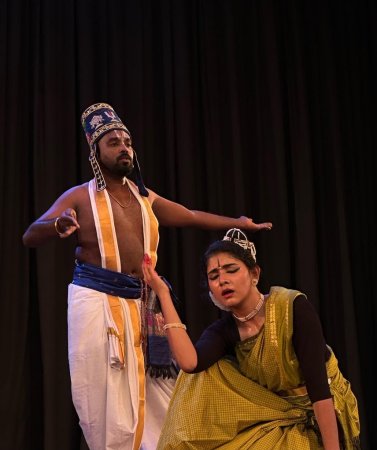 As Anita introduced the narrative, the lone but powerful voice of Madhusudhanan chanting the pasurams echoed through the stage. Anita had subtly used the male voice and the single male artiste in the production to outline the background of patriarchy. Except that patriarchy was not a topic that came for discussion then. Yet the overtures were strongly felt. Against this deep seated patriarchy, rose a woman saint who rose to be revered by men and women. And yet, fame did not come easily to her, says Anita. She had disappeared into the forgotten pages of history and it was left for the succeeding generations to discover and study with fervor and respect. Today, Andal is a household name. Even the musical ensemble consisted of an all-woman team of artistes playing the mridangam, veena, and lending vocal support. I can draw a parallel here to one of her earlier festivals that Anita had premiered at the Music Academy many years ago called Purush. Anita was the only woman representative in an all men festival. To me it was also symbolic of the fact that most representation of women remains at best mere tokenism and Naachiyar Next seemed diametrically opposite. Was Purush also representative of how Anita had to fight the race all the time in a man's world as a lone woman? Though there have been several changes that one can perceive over the years, yet some things have remained constant. There were certain constants like her irreplaceable Subhasri. Like the tirasheelai which had seen better times and yet continued to hold on. Ramani had created the open-ended Andal malai (garland) out of crushed tissue strung like real flowers, and except for a few additions on that, the rest of it was the same. I remember when she wore the malai 24 years ago on her first US presentation of Andal, she called Ramani to say how everyone had raved about it. Her enthusiasm was infectious and she was as firm and a tough task master as much as she gave the freedom and encouragement. She spoke about how she did not have a school of her own and so she had to pick out her own bouquet from the wide array of independent dancers who were ready to freelance. Of course the flip side was that she would never have the same team and it meant she would have to train them from the very beginning each a new group came. But the bonuses were that the performance would also be different every time a new artiste came for they would bring their own flavor to it. 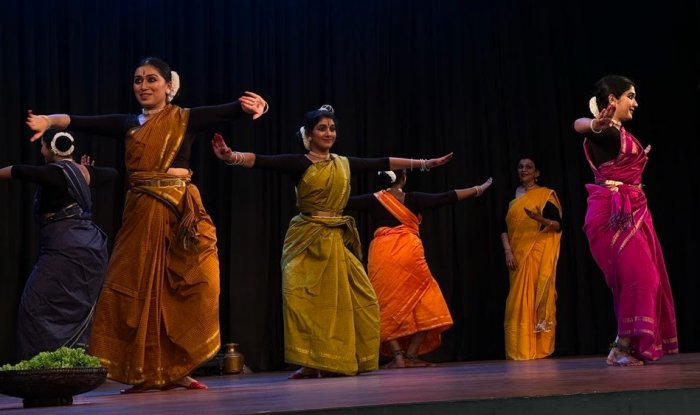 What I enjoyed about the process-narration was that the words that she spoke moved as an extended phrase even when the artistes came on stage. She spoke about the main artistes and the supporting artistes, about how she was influenced by Krishnadevaraya's Amuktamalyada, where he gives names to each of the sakhis of Andal and by doing so, Anita realized that when she adapted that idea, the sakhis of Andal would not remain nameless faces, but would build an image that would be individualistic. And so it was that each of the sakhis had their own distinct expressions throughout. It was this wide reading - of words, where letters, learning, training, assimilating and finally being able to incorporate into a cohesive, integrated whole that makes her stand apart. She says that in Naachiyar Next, she realized that she did not see the need for her to be the main character, because Andal is a young girl and a grown woman with all of herself being wrapped up in several ties can no longer perform Andal. In many other characters, heroines can be altered to suit the artiste and it would be difficult to remove that conditioning of a very young Andal from mind. But she adds, 'That is my perspective.' I could relate to that because we evolve as women from a love-sick young teenager to a young woman in the idea of love and discover that love can mean so many things to so many people and it would perhaps be juvenile to even perform the lovelorn nayika as a much older woman. I found resonance in that perspective as a woman myself. 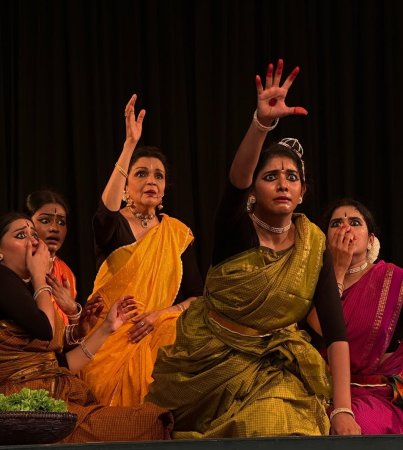 As she spoke from the wings, she also stepped into the centre of the stage as creator, director, and as an artiste too - where the past merged once again with the present. What appealed to me was the way the words and the action panned out; in lecture-demonstrations, I have always seen the teacher explain, then there is a pause as the student comes forward to explain through performance what the teacher was trying to communicate. The demonstration thus is punctuated by pauses and there is a very defined line between theory and practice. That shifted in the process elucidated by Anita, where the one melded into the action and together, they joined to complete the performance. There were no awkward pauses because even as Anita was speaking from one end of the stage, the dancers did not exit or enter with suddenness. They continued to be part of the narrative, emoting as she spoke. To me the word and action danced in perfect harmony. She spoke about the training, of taichi, of various aspects, of unlearning and relearning, of being open minded, of an entire generation where in the new age of a fast-paced world, to get rehearsal time is a tough game. There were two kinds of refrain that Anita adopted - one was Word - Ranga! This symbolized ecstasy that so overpowered them. The second refrain was Action - the Fall! What caught my attention was the Fall movement. Just as there is refrain in music, she used the fall as a refrain which became the leitmotif of the production. And, to me, every time, Andal fell especially into Anita's arms, I saw the Past Andal merge with the Present. It was a moment where I saw the transference of energy from the old to the young. As it ended however, I saw how Anita was once again with her young Andal. Except that as Andal fell into a trance, I saw Anita in her yellow peetambaram as Krishna ready to envelop His Andal into his bosom. 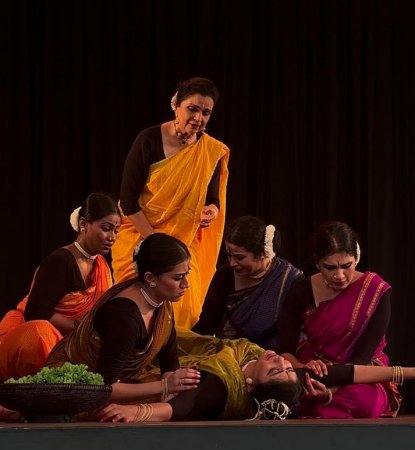 Being an artiste who refused to box herself into a given slot, whether in terms of space/region or in terms of idea, it came as no surprise that she brought the likeness of Andal to St.Teresa of Avila, who founded the discalced Carmelite religious order. St. Teresa experienced angelic encounters and while she was praying, an angel appeared and pierced her heart with a spear of fire that sent God's pure, passionate love into her soul that sent her into ecstasy. As the performance and the narration ended, I saw the many years condense into an hour that gave one a glimpse into the artiste called Anita Ratnam. I looked into the years that she had spent learning, assimilating, being open-minded to invite critiquing, working on her strengths. But it did not stop there; she continued to give back and to share even as she was performing. If Narthaki was about her willing to throw open her contacts for a closer world, the revival of Kaisiki Natakam was her way to give back to society. I discovered that even in this seemingly simple session, the humaneness of a gentle artiste who made sharing and giving her watchword came through. 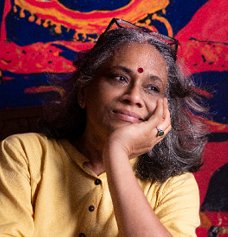 Hema Iyer Ramani is a writer and essayist focusing on travel, culture, art and leisure. She is the author of Soulscapes: Travel and Conversations in India, a nuanced exploration of the physical, emotional and spiritual connections between people and places. A multi-faceted talent, Hema also works alongside her artist-husband V.V. Ramani, collaborating on set and costume design for dance performances, events and weddings. |